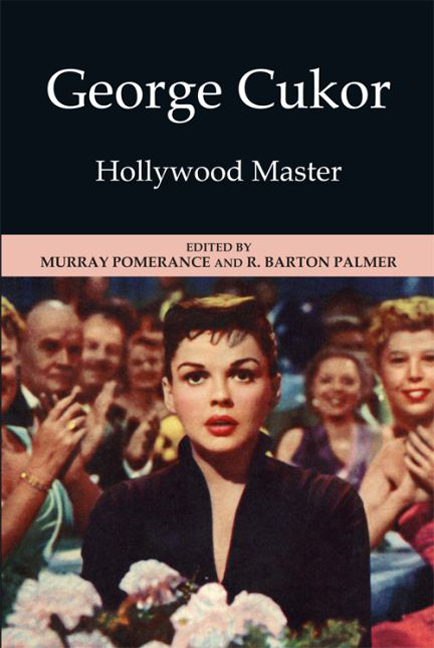Book contents
- Frontmatter
- Contents
- List of Figures
- List of Contributors
- Acknowledgments
- Introduction
- 1 Cukor's Tragicomedies of Marriage: Dinner at Eight, No More Ladies, The Women, and The Marrying Kind
- 2 George Cukor's Late Style: Justine, Travels With My Aunt, and Rich and Famous
- 3 Libel, Scandal, and Bad Big Names: It Should Happen to You, Les Girls, Camille, and Romeo and Juliet
- 4 The Cukor “Problem”: David Copperfield, Holiday, and The Philadelphia Story
- 5 Modulations of the Shot: The Quiet Film Style of George Cukor in What Price Hollywood?, Born Yesterday, Sylvia Scarlett, and My Fair Lady
- 6 Doubling in the Cinema of George Cukor: The Royal Family of Broadway, A Bill of Divorcement, A Double Life, and Bhowani Junction
- 7 George Cukor and the Case of an Actor's Director: Hepburn and/or Tracy in Little Women, The Actress, Keeper of the Flame, Adam's Rib, and Pat and Mike
- 8 Cukor Maudit: Tarnished Lady, Girls About Town, Our Betters, Susan and God, Desire Me, Edward, My Son, The Model and the Marriage Broker, Let's Make Love, and The Chapman Report
- 9 George Cukor's Theatrical Feminism: Gaslight, Heller in Pink Tights, A Life of Her Own, and A Star is Born
- 10 The Furthest Side of Paradise: Two-Faced Woman, A Woman's Face, Hot Spell, Wild is the Wind, and Winged Victory
- Works Cited and Consulted
- Index
5 - Modulations of the Shot: The Quiet Film Style of George Cukor in What Price Hollywood?, Born Yesterday, Sylvia Scarlett, and My Fair Lady
Published online by Cambridge University Press: 07 October 2017
- Frontmatter
- Contents
- List of Figures
- List of Contributors
- Acknowledgments
- Introduction
- 1 Cukor's Tragicomedies of Marriage: Dinner at Eight, No More Ladies, The Women, and The Marrying Kind
- 2 George Cukor's Late Style: Justine, Travels With My Aunt, and Rich and Famous
- 3 Libel, Scandal, and Bad Big Names: It Should Happen to You, Les Girls, Camille, and Romeo and Juliet
- 4 The Cukor “Problem”: David Copperfield, Holiday, and The Philadelphia Story
- 5 Modulations of the Shot: The Quiet Film Style of George Cukor in What Price Hollywood?, Born Yesterday, Sylvia Scarlett, and My Fair Lady
- 6 Doubling in the Cinema of George Cukor: The Royal Family of Broadway, A Bill of Divorcement, A Double Life, and Bhowani Junction
- 7 George Cukor and the Case of an Actor's Director: Hepburn and/or Tracy in Little Women, The Actress, Keeper of the Flame, Adam's Rib, and Pat and Mike
- 8 Cukor Maudit: Tarnished Lady, Girls About Town, Our Betters, Susan and God, Desire Me, Edward, My Son, The Model and the Marriage Broker, Let's Make Love, and The Chapman Report
- 9 George Cukor's Theatrical Feminism: Gaslight, Heller in Pink Tights, A Life of Her Own, and A Star is Born
- 10 The Furthest Side of Paradise: Two-Faced Woman, A Woman's Face, Hot Spell, Wild is the Wind, and Winged Victory
- Works Cited and Consulted
- Index
Summary
It's easier to do justice … to dialogue and characterization than to the rhythms and felicities of visual style.
Carlos Clarens, George Cukor (1975), p. 119In a brief essay on Cukor, Ed Buscombe identifies what he calls the director's critical problem, highlighting the extent to which Cukor's films have eluded rigorous analysis: while there is a clear consensus within the literature about the quality of the films and their enduring appeal as Hollywood texts, critics have been disinclined to scrutinize them at the level of style, so as to specify a distinc¬tive film aesthetic. In other words, we know much about the broad themes, narra¬tive turns, and luminous personalities of Cukor's cinema, but very little about the patterning of images and sounds that animate his films, lending substance and energy to their premises and preoccupations. Written in 1973, Buscombe's commentary reflects the concerns of its disciplinary context, pursuing an alignment of critical approaches between auteurism and structuralism. But for contemporary scholarship, the difficulty he mentions is still germane: forty years on, assessments of Cukor remain frustratingly imprecise, sustaining the impres¬sion that perhaps there is “nothing to say” about his cinema.
In this discussion, I want to offer something more concrete about the cinematographic style of Cukor's work, so that we might obtain greater scholarly purchase on it. This effort will necessarily entail an acknowledgment of the films’ resistance to such schemes, as well as a sensitivity to their formal restraint. If critics have failed to describe Cukor's style definitively, this lapse can lead us back productively to the films themselves, reappraising their self-effacement. In what follows, I will outline some of the challenges to analysis that Cukor's films present, and the limitations of the received criticism, before examining a range of diverse titles to see what can be discovered about their formal char¬acter. Specifically, I will point to particular modulations of the shot that prove characteristic for Cukor's cinema, related to their realistic texture and canny framings. This analysis finds fresh affinities across Cukor's oeuvre, extending from the early projects What Price Hollywood? (1932) and Sylvia Scarlett (1935) to the commercial successes of Born Yesterday (1950) and My Fair Lady (1964).
- Type
- Chapter
- Information
- George CukorHollywood Master, pp. 77 - 91Publisher: Edinburgh University PressPrint publication year: 2015



